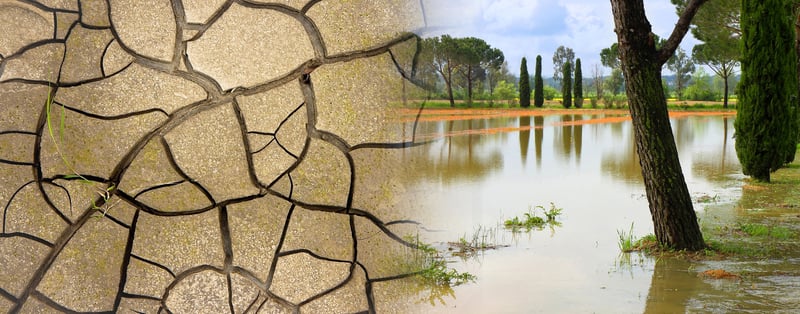The unpredictability of rainfall is a major water supply problem. When it’s raining, we must find ways to capture and store it while leaving enough to sustain natural systems. But, often, there’s more rain than we or nature can absorb, resulting in flooding. On the opposite side of that concern is experiencing drought. One thing is certain, water security is essential, and there is no time for uncertainty. Water managers, utilities, and regulators are working to find solutions and funding on every end.
Are there any solutions to flooding?
To start, we can build reservoirs to capture the rain when it is abundant and to ensure there is water when rainfall disappoints. Then again, predicting and relying on rainfall has its issues. Identifying and developing new water supplies is also more complicated than ever.
We can develop technologies like aquifer storage and recovery, where we capture river flows or rainfall, treat it, and store it underground. But this solution is rainfall dependent.
Related: Aging Infrastructure - Texas Water
In drought-stricken regions, what happens when it doesn't rain?
We can look west toward the Colorado River and see the consequences of relying on rainfall (or snowmelt). The region that includes San Antonio has had an extended drought, and even summer rains barely brought relief. The National Weather Service says Texas can expect more droughts and that they will last longer.
Residents of a small town in California are using bottled water for everything as their allocation from the Colorado River has been cut several times. Meanwhile, a small town in Arizona with 3,500 customers needs to spend more than $20 million to extend an intake pipe as river water levels drop.
You may also be interested in: Show Me the Money - Texas Water
What happens to Laredo, TX, as the impact of the drought continues to impact the Rio Grande? What happens when that drought is as long as the one plaguing the West and the Colorado River?
The Texas Water Development Board has a plan for the future, but the execution of the plan requires money. Currently, a wealth of infrastructure funding is available through the Infrastructure Investment and Jobs Act (IIJA) for desperately needed water and wastewater treatment and delivery systems.
However, that money can be out of reach for small and rural Texas communities even though funds are specifically set aside for them. The good news is that the American Rescue Act funding can be used to get the necessary critical technical assistance.
We know what is coming...uncertainty. We know what we need…water security. Now is the time for Texas to take steps to ensure water supply sustainability and resiliency.
Visit waterworks4texas.com today to learn more.
About the Author
Carlos Rubinstein
Water Policy Consultant, Anser Advisory

Rubinstein is an expert on Texas water policy. As chairperson of the Texas Water Development Board (2013-2015) he oversaw the implementation of the $2 billion State Water Infrastructure Fund. (SWIFT). He is a Board Member of the Texas Water Foundation and the Texas Water Trade. Rubinstein has served as the Texas representative to the Western States Water Council, and the Border Governors' Conference Sustainable Development worktable. Rubinstein served as a commissioner of the Texas Commission on Environmental Quality (TCEQ) from 2009–2013. He is a former deputy executive director of TCEQ and Rio Grande Watermaster. Rubinstein has appeared as an expert witness on various environmental cases and has published several peer-reviewed articles on Texas water policy. He is a former city manager for the City of Brownsville. Rubinstein earned a bachelor's degree in biology from Pan American University.


